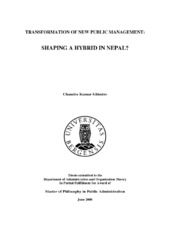Transformation of New Public Management: shaping a hybrid in Nepal?
Master thesis
Permanent lenke
https://hdl.handle.net/1956/4440Utgivelsesdato
2008-08-04Metadata
Vis full innførselSamlinger
- Department of Government [457]
Sammendrag
This study finds evidences in support of a thesis of divergence in shaping of new public management (NPM). The underpinning of the study is that NPM gains a new hybrid shape as it goes through a complex interactive process of transformation. This study delved deeply into the shaping process of NPM in Nepal. The scope of this study includes mapping out the actors, processes and contents involved in decisions of NPM-inspired reforms and analyzing the causal factors involved in the approval decisions. Drawing upon the two cases Strategy Paper of Government of Nepal on Financial Sector Reform Program (SPGNFSRP); and Governance Reform Program Roadmap (GRPRM), a qualitative field study was conducted mainly with senior officials of relevant ministries, agencies, donor agencies and NGOs. The inquiry primarily focused on: What forms of the actors, processes and decision-contents were appeared? What factors were influential to affect the decisions? In the analysis, this study combined model of NPM transformation of Christensen and Lægreid with three perspectives of organization theory: 1) instrumental 2) cultural and 3) environmental. This study found the evidences that the actors are exhibited central and peripheral roles and hence are classified accordingly. All central actors involved such as ministers of finance, senior bureaucrats and senior technocrats of concerned ministries and donor agencies along with other peripheral actors shown supportive roles. While a few peripheral actors shown opposition. Similarly, I learned the processes in the SPGNFSRP to be less democratic, more closed, more top-down, more consequentiality and more stable whereas the opposite was the processes of the GRPRM. The contents of the SPGNFSRP acquired high market and high management elements, thus, are referred as market-driven case'. Since the GRPRM obtained low market and high management elements, it is referred as mixed case'. This study also found that a coalition of deliberate planned and hierarchical decision-making of superior organizations, fiscal crises and reform doctrines of donors and international agencies strongly contributed to the NPM-inspired decisions in both cases. However, domestic political opposition and insurgency partly contributed to the decisions but the elite orientation in bureaucrats had little or played no roles. Finally, this study revealed that a new hybrid emerged in the cases via the complex interactive model of NPM transformation. Looking through the theoretical lens, I observed that the instrumental and environmental perspectives circumscribed the cultural perspective in producing a new NPM hybrid.
Utgiver
The University of BergenOpphavsrett
The authorCopyright the author. All rights reserved
